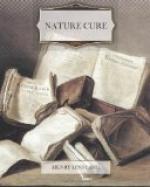After this brief discussion of the practical application of homeopathy, let us now ascertain in how far its laws and theories agree with and corroborate the laws and principles of the Nature Cure school.
Hahnemann discovered the Law of similia similibus curantur accidentally, while investigating the effects of quinine on the human organism. Ever since then it has been applied successfully by him and his followers in treating human ailments.
However, this law has been used empirically. Neither in the Organon nor in any other writings or teachings of Hahnemann and the homeopathic school can be found a clear and concise explanation of why like cures like. The proof offered has been negative rather than positive.
Therefore the allopath says: “You tell me that ’like cures like,’ and that you can prove it at the sickbed; but unless you can give me good and valid reasons why it should be so, I cannot and will not believe that it is your ‘similar’ which cures the patient. How do I know it is your ‘potency’? The patient might recover just as well without it.”
With the aid of the three laws of cure, I shall endeavor to give the reasons and furnish the proofs for our contentions. The laws alluded to are: The Law of Cure, the Law of Dual Effect and the Law of Crises.
Similia similibus curantur is only another way of stating the fundamental Law of Nature Cure: “Every acute disease is the result of a cleansing and healing effort of Nature.”
If a certain set of disease symptoms are the result of a healing effort of Nature, and if I give a remedy which produces the same or similar symptoms in the system, am I not aiding Nature in her attempt to overcome the abnormal conditions?
In such a case, the indicated homeopathic remedy will not suppress the acute reaction, but it will help it along, thus accelerating and hastening the curative process.
In the last analysis, disease resides in the cell. The well-being of the organism as a whole is dependent upon the health of the individual cells of which it is composed. This has been explained more fully in connection with the action of stimulants.
In order to cure the man, we must free the cell of its encumbrances. Elimination must begin in the cell, not in the organs of depuration. Laxatives and cathartics, by irritating the digestive tract, may cause a forced evacuation of the contents of the intestinal canal, but they do not eliminate the poisons which clog cells and tissues.
In stubborn chronic diseases, when the cells are too weak to throw off the latent encumbrances of their own accord, a well-chosen homeopathic remedy is often of great service in arousing them to acute reaction.
For instance, if the system is heavily encumbered with scrofulous taints and if its vitality is lowered to such an extent that the individual cell cannot of itself throw off the morbid encumbrances by means of a vigorous, acute effort, sulphur, if administered in doses sufficiently triturated and refined to affect the minute cells composing the organism, will start disease vibrations similar to those of acute scrofulosis, and thus give the needed impetus to acute eliminative activity on the part of the individual cell.




